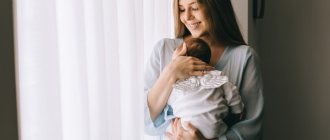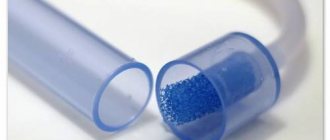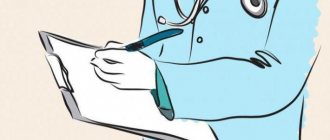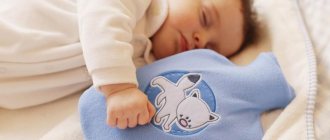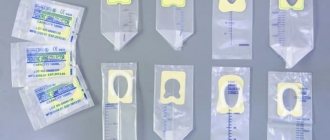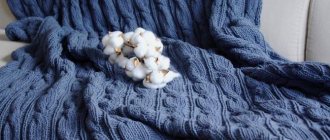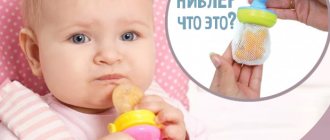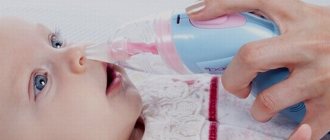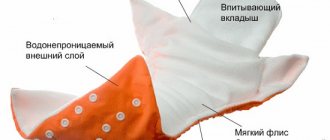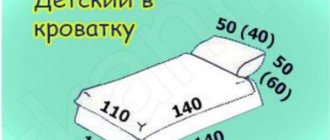The need for a syringe in a first aid kit for a newborn
A syringe is a medical instrument used in the process of delivering or pumping out liquids. The device is intended for washing, irrigation with water or medicinal substances, cleansing the rectum, nose, and releasing gases.
You can use a syringe for the following purposes:
- dilution and elimination of the contents of the lower intestines for colitis of any origin, difficulty stool;
- to remove toxic elements from the body;
- before surgical interventions;
- when diagnosing the functioning of the digestive tract (before X-ray or endoscopic examination);
- when administering medicinal enemas;
- for cleaning nasal passages and sinuses.
A medicinal enema is a method of local therapy. Pediatricians prescribe the procedure in cases of inflammation, spasms, and parasites in the body. Inflammatory reactions can be provoked by colitis and adnexitis. Antiparasitic treatments are aimed at getting rid of helminths and protozoa.
When carrying out the procedure, you should follow safety rules, as otherwise negative consequences may occur.
The safety basis includes the following aspects:
- correct treatment of the device before and after procedures;
- lubricating the tip with safe fat (lanolin, Vaseline, baby oil);
- careful insertion into the rectum;
- infrequent use of the method.
Failure to comply with safety rules may result in the following consequences:
- introduction of infection into the body;
- causing injury to the rectum or nasal mucosa;
- leaching of beneficial microorganisms from the intestines;
- intestinal atony (weak peristalsis).
What does a syringe look like?
A syringe for newborns is available for sale in pharmacies and specialized medical equipment stores.
Syringe for newborns
When purchasing, you should pay attention to the following characteristics of the devices:
- evenness of color;
- tightness of the connection between the cylinder and the tip;
- the appearance of the tip, which should be free of cracks, underfilling, contamination, and burrs;
- to the manufacturer (for trusted manufacturers, the quality of devices does not change after cleaning and disinfection);
- the manufacturing material should not contain substances that cause allergic reactions or poisoning;
- the balloon must be soft and flexible;
- there should be no pores or depressions on the surface of the product.
Form
The syringe is a pear-shaped round balloon with a soft tip. As a device for older children, a special vessel with a capacity of 200-300 mg, available for sale in pharmacies, can be used. Product parameters depend on their volume.
The smallest sizes of syringes intended for newborns vary among different manufacturers as follows:
- length 45-50 mm;
- width 45-50 mm;
- height 80-90 mm.
Materials
The following materials can be used for the manufacture of cylinders with tips:
- Polyvinyl chloride (in cylinders) has the following characteristics:
- chemical neutrality to interaction with water, alcohol, organic hydrocarbons;
- resistance to chemical compounds of acids, alkalis, salt solutions;
- conductivity of electric current;
- operating temperature up to +65°C.
- Glass or plastic (in nozzles for nasal discharge in infants).
- Polypropylene (in tips) has the following properties:
- high resistance to reagents (acid-base environments, saline solutions);
- insolubility in organic substances at ambient temperatures up to +25°C;
- solubility in aggressive media when the temperature rises (in benzenes, carbon tetrachloride, ether);
- low moisture absorption;
- good electrical insulating properties over a wide temperature range.
- Non-toxic plastisol in tips is a substance formed from a dispersion of particles of special types of polymers in a liquid plasticizer. The material has good physical and mechanical properties, high electrical resistance and chemical resistance.
Size, volume
The syringe for newborns is available for sale in a model line that varies in size. The volume of products intended for a child from birth to one year is 27 - 60 ml. For older children (from 1 to 14 years old), rubber cans are available.
There is a standard size marking according to the age of children:
- “A No. 3” capacity is within 27±7 ml, the product is intended for newborns and infants up to six months;
- “A No. 7” can hold 70±10 ml, the size is used up to two years of age;
- “A No. 11” volume is characterized by a capacity of 230±30 ml of substance, the device is designed for children aged 2-6 years;
- “A No. 13” has a volume of 317±30 ml, the syringe is used at the age of 6-9 years;
- “A No. 14” has a capacity of about 490±50 ml, the product is designed for teenagers 10-14 years old or adults.
How can you clean your baby's nose?
Cleansing manipulations of the respiratory tract are an unpleasant hygienic procedure for infants. He will turn his head and cry, and therefore you need to be extremely careful. Modern pediatricians, such as Dr. Komarovsky, do not recommend doing the following:
- Use your mouth to suck mucus out of your newborn's nose.
- Drip breast milk into the baby's nostrils, which can immediately develop microbes.
- Do not use cotton swabs or matches with cotton wool wrapped around them for cleaning; these devices can injure the baby’s nasal mucosa.
Before you start cleaning your newborn's nose, you need to prepare all the necessary items in advance. The choice of such devices for cleaning the respiratory tract depends on the degree of blockage of the nose, the age of the child, and the reason for the procedure (congestion, daily care). Let's look at the most common spout cleaning tools, their types and methods of use.
Aspirator
A special hygienic device for suctioning mucus in newborns, which does not cause discomfort, is called an aspirator. Before using this device, the spout is slightly moistened with a special solution. There are several types of aspirators:
- Mechanical. It is a small transparent container for snot with a straw and removable nozzles. One end of the tube is inserted into the newborn's nostril; through the second, the mother sucks in air and draws mucus from the nose into a special container.
- Electronic. This is a special battery-powered “pear” that, at the press of a button, pulls out snot. An electronic aspirator often has additional functions - humidification, aerosol.
- Vacuum. This device is used very rarely at home. In appearance, it resembles a mechanical aspirator, but it works by connecting to a special vacuum cleaner. It's inconvenient, noisy, cumbersome.
Aquamaris
To moisturize the mucous membrane of a newborn's nose and soften the crusts, use Aquamaris natural sea water. This drug can be used by infants under one year of age only in the form of drops; the spray is used for children over 1 year of age. Aquamaris drops contain many microelements and active substances, thanks to which the drug perfectly removes dust, takes care of the normal functioning of the nasal mucosa, and increases local immunity.
Syringe
The easiest to use and most common aspirator is a syringe. In appearance, it resembles a regular “pear”, but has a special removable silicone tip. For newborns, small syringes with soft silicone nozzles are used. The principle of operation of the device is simple - you squeeze the syringe with your hand so that the air comes out of it, and then you need to insert the tip into the baby’s nostril, gently open the bulb and pump out the mucus.
Pear
This is a traditional device that our mothers and grandmothers used. It was made of dense rubber and had a thin and soft tip. Using such a device is inconvenient and traumatic for a newborn. Modern pears have been improved:
- they have a wide tip that does not go too deep into the nostril;
- The tip of the device is removable, it can be easily unscrewed and washed;
- The material of the bulb is silicone, which is much stronger than rubber and leads to less mucus suction force.
Cotton flagella
To remove small amounts of snot, crusts, and for daily hygiene procedures with a newborn, cotton pads are used. To make such a flagellum, you need to twist it from a piece of long cotton wool. Next, the device is lightly moistened with a special solution or sterile Vaseline and inserted into one nostril of the baby with slow rotational movements to a depth of 2 cm, then slowly and carefully removed. The procedure is repeated for the other nostril, but a new flagellum is used.
In what cases is it used?
At home, using a device, you can make a cleansing enema using medicinal solutions.
The body cleansing procedure is used in the following cases:
- when fastening the chair;
- parasite infestations;
- when toxic manifestations are observed (allergic reactions, poisoning).
The amount of water or solutions administered depends on the child’s age, which are given below. Experts recommend maintaining the liquid temperature within 35-37°C.
Babies under one year old can have medicinal enemas only after consultation with a pediatrician. You cannot resort to the procedure if there is 1-2 days of stool retention and the child feels well (is not capricious, looks healthy). The norm is the absence of bowel movements for 2-3 days.
Children under six months old often suffer from colic, which is associated with the accumulation of gas. Using a syringe you can carry out a procedure to alleviate the condition. Also, the device, if equipped with a special nose attachment, can clear the sinuses and passages during a runny nose. There are a number of contraindications for which the use of syringes is prohibited.
These include:
- inflammation of appendicitis;
- intestinal obstruction;
- hernias;
- the presence of acute infectious diseases.
How to clean a baby's nose?
This procedure is carried out as necessary. If the newborn’s breathing is good, he is not capricious, does not give alarm signals, and the necessary conditions are selected in the apartment, then there is no need to worry about anything and it is not necessary to clean the child’s nose.
During illness, it is necessary to clean mucus from a newborn’s nose several times a day. This is best done before feeding and bedtime. Of course, a small amount of mucus will come out on its own when the baby drinks from a bottle or suckles, but if there is too much of it, the baby will not be able to cope with this problem on his own. There are several ways to clear mucus from your nose. Let's look at them in more detail.
Cotton buds
This method of clearing the nose is considered the least safe and effective, as it can injure the child or push the mucus even deeper. Even when using special baby cotton swabs, it is possible to cause discomfort to the newborn, because they are much wider than the baby’s sinuses. But if this method was chosen, the crusts must be softened first.
Cotton buds and pear
Cotton buds can be used to clean the nose well, removing boogers, but they do not remove all the mucus. To make a flagellum, you need to separate the cotton pad. One half is made into four equal parts, each of which is rolled into a thin cone. Before cleaning a newborn's nose, the flagellum should be slightly moistened. It is then placed in the nostril and scrolled. If this is required, the procedure is repeated many times.
You can also clean your nose with a blower, but it is not able to completely remove all the mucus. This device is considered the safest and is practically impossible to injure a child. It is advisable to purchase special syringes for children with a soft rubber tip.
Aspirator
This is a special device that works on the same principle as a pear, but more advanced. It has virtually no drawbacks, but many are stopped by the high cost. An aspirator can be:
- mechanical;
- electronic;
- vacuum.
Aids
To prevent the newborn's mucous membranes from drying out, the nose should be regularly washed and treated with special compounds. This not only moisturizes the sinuses, but also prevents infection from entering the nasopharynx. There are special means for clearing mucus from the nose.
Saline solution of sodium chloride is considered practically the best liquid that is used to moisturize crusts and soften them. It is sold in any pharmacy. The saline solution should be used before each cleaning of the nose, placing two drops into each nostril with a sterile baby pipette.
Saline solution is an analogue of saline solution that can be made at home. To do this, dissolve a teaspoon of table salt in a liter of warm boiled water. Before cleaning a newborn’s nose from boogers, the solution should be brought to a temperature of 35 – 37 degrees. It is used in the same way as saline solution.
Over-the-counter products can also be used to soften and moisten the nose.
Rules for processing the product before and after use
A syringe for newborns can be easily used at home.
Before use, the pear must be disinfected; this can be done in two ways:
- Boil in clean water for 30 minutes.
- Immerse the balloon with the tip in a 3% hydrogen peroxide solution for 10 minutes. Then the device must be removed and rinsed under running water.
Before using the syringe, its tip should be lubricated with petroleum jelly, lanolin or baby oil.
Contact of the product with medicinal substances for more than 30 minutes is not allowed.
After the procedures, the syringe should be rinsed with hot water and dried.
Technological protocol for newborn care
GOU VPO "Kemerovo State Medical Academy"
ROSZDRAVA
Kemerovo Regional Clinical Hospital
Technological protocol for newborn care
Kemerovo 2006
UDC 616 - 036.22
Authors:
| Candidate of Medical Sciences, Chief Physician of the Kemerovo Regional Clinical Hospital I.P. Leverages | Doctor of Medical Sciences, Professor of the Department of Epidemiology of the State Educational Institution of Higher Professional Education "Kemerovo State Medical Academy" E.B. Brusina |
| Doctor of Medical Sciences, Professor of the Department of Epidemiology, Kemerovo State Medical Academy O.M. Drozdova | Candidate of Medical Sciences, Head of the Epidemiological Department of the Kemerovo Regional Clinical Hospital N.B. Karpushkina |
| Candidate of Medical Sciences, Head of the Maternity Department of the Kemerovo Regional Clinical Hospital L.B. Nikolaev |
The technological protocol for the care of newborns has been prepared to unify the work of the nurse in the newborn ward and the midwife in the delivery room in order to ensure the infectious safety of medical technologies for both newborns and staff. The technological protocol is intended for medical personnel of maternity hospitals and epidemiologists.
Reviewers:
Doctor of Medical Sciences, Professor N.V. Artymuk, Ph.D. I.A. Demin
The technological protocol was approved by the Academic Council of the Kemerovo State Medical Academy “_____” ____________ 2006. Department of Population Health Protection of the Kemerovo Region “____” ___________ 2006
© Rychagov I.P., Brusina E.B., Drozdova O.M., Karpushkina N.B., Nikolaeva L.B.
© State Healthcare Institution Kemerovo Regional Clinical Hospital.
© State Educational Institution of Higher Professional Education KemSMA.
Table of contents
Section 1. Requirements for the placement and equipment of wards for newborns
Section 2. Protective clothing
Section 3 Hand treatment
Section 4. Treatment of a newborn in the delivery room
Section 4.1. Technology of primary treatment of a newborn in the delivery room
Section 4.2. Technology for secondary treatment of a newborn in the delivery room
Section 5. Treatment of a newborn in the ward. Preparing the manipulation table for work in the ward for newborns
Section 5.1. Technology of morning treatment of a newborn in the ward
Section 5.2. Technology for treating the eyes, nasal passages, ears and face of a newborn
Section 5.3. Technology for treating the umbilical wound of a newborn
Section 5.4. Technology of swaddling a newborn
Section 6. Routine cleaning of neonatal wards
Section 7. General cleaning by type of final disinfection
Section 10 Protection of personnel from infection
Literature
Section 1.
Requirements for the placement and equipment of wards for newborns.
In accordance with sanitary standards, the area of the room for 1 bed of a newborn in the physiological department must be at least 3 m2, in the observation department - 4.5 m2 per 1 newborn.
The walls and ceiling of the room must be covered with moisture-resistant paint. Moisture-proof materials (linoleum, tiles, etc.) are used to cover the floors.
The room is equipped with a sink with hot and cold water supply and a faucet with elbow or pedal control, supply and exhaust ventilation with mechanical drive and natural ventilation through vents, transoms, etc.
The surfaces of heating devices must be smooth, painted, and easily subject to wet cleaning.
The ward room is equipped with natural, general and local artificial lighting. Artificial lighting can be provided by both fluorescent and incandescent lamps. General lighting fixtures must have solid (closed) diffusers.
Each room is equipped with closed, open or combined ultraviolet bactericidal lamps. Their number is calculated in accordance with Guideline R 3.1. 683 – 98 “Use of ultraviolet bactericidal radiation for disinfection of indoor air and surfaces.”
The room contains: a manipulation table, medical scales for weighing newborns, a changing table, beds for newborns, a tank for used diapers, a container with a disinfectant and sterile rags. Furniture must have moisture-resistant surfaces that can be disinfected. A wall thermometer is attached to the wall of each room. The temperature in the rooms should be maintained within 22-240 C, air humidity - 60%. Mattresses for newborns should be in tightly sewn, waterproof covers, which, after the child is discharged, are treated with disinfectants.
Sterile diapers, medications and packs are stored in separate rooms. Sterile diapers in packages should be stored in a special cabinet. Medicines are placed in the cabinet in accordance with the requirements of pharmaceutical regulations. Bixes with sterile material and bins prepared for sterilization are stored in different compartments of the cabinet.
The wards are filled strictly cyclically (within 3 days).
Section 2.
Protective clothing.
* Cotton shirt or suit: shirt and trousers;
* sterile medical gown;
* oilcloth apron;
* hat or scarf;
* shoes that must be washed and disinfected.
* disposable mask (used according to epidemic indications, changed every 4 hours).
Procedure for putting on gloves.
* with the thumb and forefinger of your right hand, grab the turned-down edge of the left glove from the inside and carefully pull it onto your left hand;
* place the fingers of the left hand wearing a glove under the lapel of the back surface of the right glove and pull it over the right hand;
* without changing the position of the fingers, unscrew the curved edge of the glove;
* also unscrew the edge of the left glove;
Procedure for removing gloves.
* make a lapel on the left glove with the fingers of your right hand, touching only the outer side;
* remove the glove from your left hand, turning it inside out and holding it by the lapel. Hold it in your right hand;
* take the right glove with your left hand by the lapel from the inside;
* remove the glove from your right hand, turning it inside out: the left glove is inside the right;
* place gloves in a disinfectant solution (a solution for disinfection according to the regime of viral hepatitis);
Procedure for removing the robe.
* remove the robe first from one hand, touching only the lower part of the sleeves4
* remove the robe from the second hand, touching it from the inside and turning it inside out;
* place the robe in a container marked “Dirty laundry”;
* the robe is changed daily or more often if necessary.
Procedure for removing the mask.
* remove the mask, touching only the ties;
* place the mask in a container with a lid for subsequent disinfection by boiling;
The staff takes a hygienic shower every day before going on shift. Clothes are changed daily.
Attention! Persons with inflammatory or purulent processes, malaise or fever are not allowed to work!
| Section 3 Hand treatment | ||
Wash the hands:
| ||
| ||
| ||
| ||
| ||
| ||
| ||
| ||
| ||
Section 4.
Treatment of a newborn in the delivery room.
Treatment of a newborn after birth is carried out in the children's room of the delivery room (manipulation and toilet room), where there is a changing table, a manipulation table, scales for weighing the newborn, a bix table with sterile individual settings for treating the newborn, a cabinet with medicines and sterile consumables, an artificial ventilation, electric suction.
The changing table should be heated or with heat lamps, a mattress covered tightly with waterproof oilcloth. On the inner surface of the back or side of the changing table there should be markings of up to 60 cm to measure the growth of the newborn.
Next to the changing table there is a bedside table with scales for weighing the newborn and a manipulation table with items for caring for the newborn: working tweezers in a sterile diaper; bottles with 960 alcohol, 5% solution of potassium permanganate or 1% alcohol solution of brilliant green; sterile petroleum jelly in individual packaging, a syringe tube with a 20% sodium sulfacyl solution or another approved drug for the prevention of gonoblenorrhea. On the bottom shelf of the manipulation table there are: a tray for waste material, a container with a disinfectant for treating the surfaces of the changing table, manipulation table and scales for the newborn.
A bix with sterile individual settings for treating a newborn and changing kits is placed on a separate table. The styling includes: scissors, silk or gauze ligature with a diameter of 1 mm and a length of 10 cm; 2-3 gauze triangles (for the umbilical cord stump), 3-4 wooden sticks with cotton wool, 6-7 cotton balls, a tape for measuring a newborn, bracelets and a medallion. The changing kit includes 3-4 sterile diapers.
The cabinet contains medications and sterile consumables: disposable sanitary catheters, endotracheal tubes, syringes, etc.
Section 4.1.
Technology of primary treatment of a newborn in the delivery room.
- Wash your hands according to the method specified in section 3;
- Treat your hands with an alcohol-based skin antiseptic;
- Dry your hands with a sterile cloth;
- Wear a sterile cap, mask, gown, gloves;
- Using sterile working tweezers, remove the sterile individual set for initial treatment of the newborn from the bix and place it on the tray prepared for use;
- Unfold 2 sterile diapers on a disinfected tray for receiving a newborn;
- Place the born baby on a tray;
- Remove 2 sterile cotton swabs from the packaging for initial treatment of the newborn;
- Holding the child's eyelids with cotton swabs (one for each eye), apply drops from an individual syringe tube with a 20% sodium sulfacyl solution to the eyes, and for girls, to the external genitalia. After 10 minutes, repeat the eye treatment 2 times with an interval of 10 minutes.
Attention! Prevention of gonoblenorrhea can be carried out by instilling a single 1% solution of protargol from an individual bottle into the eyes of a newborn at the mother’s feet using a disposable pipette or syringe tube. Tetracycline eye ointment can also be used, which is placed behind the lower eyelid with sterile spatulas (separate for each eye).
- Place one Kocher clamp on the umbilical cord at a distance of 10 cm from the umbilical ring, the second clamp - at a distance of 8 cm from the umbilical ring, the third - as close as possible to the woman’s external genitalia;
- Treat the area of the umbilical cord between the first and second clamps with a cotton ball soaked in 960 alcohol and cut with scissors;
- Treat the section of the child's umbilical cord stump with a cotton ball moistened with a 5% solution of potassium permanganate (1% solution of iodonate or other approved antiseptic);
- Show the child to the mother, drawing her attention to the sex of the child and congenital developmental anomalies, if any;
- Transfer the newborn to the manipulation and toilet room for newborns in the delivery room.
Section 4.2.
Technology for secondary treatment of a newborn in the delivery room.
- Remove a sterile gauze pad from the individual placement for secondary treatment of the newborn and use it to squeeze out the umbilical cord residue from the base to the periphery;
- Treat the umbilical cord residue with a gauze ball moistened with 960 alcohol;
- Take a ligature and fix it at a distance of 3-4 mm from the skin edge of the umbilical ring;
- Cut off the umbilical cord with sterile scissors at a distance of 3-5 mm from the upper edge of the ligature;
- Treat the cut surface, the base of the umbilical cord and the skin around the umbilical ring with a cotton swab moistened with a 5% solution of potassium permanganate;
- Apply a sterile gauze bandage to the umbilical remnant;
- Take sterile cotton swabs and soak them in sterile petroleum jelly from an individual bottle;
- Using light movements, remove blood, vernix, mucus and meconium from the newborn’s head and body;
- Dry the newborn's skin with a sterile diaper;
- Weigh the newborn while wrapping him in another sterile diaper;
- Take a sterile measuring tape and measure the height of the newborn - from the back of the head to the heel tubercles; head circumference - along a line passing through the frontal tubercles and the back of the head in the area of the small fontanel; chest circumference - along the line of the nipples and armpits;
- Take out the bracelets and medallion, write on the bracelets and medallion the surname, first name, patronymic, birth history number of the mother, gender of the child, weight, height, hour and date of birth;
- Treat your hands with an antiseptic, tie bracelets to the newborn’s hands;
- Swaddle the newborn (the swaddling technology is specified in section 9);
- Attach the medallion to the top diaper.
Section 5.
Treatment of a newborn in the ward.
Preparing the manipulation table for use in the neonatal ward.
On the treated manipulation table, working tweezers in a sterile diaper, bottles with sterile water, 96o alcohol, 5% potassium permanganate solution or 1% alcohol solution of brilliant green, sterile petroleum jelly, 3% hydrogen peroxide solution are placed. Next to the manipulation table there should be a box with sterile packing for newborns. The styling includes: a kidney-shaped tray, 6-8 cotton balls, tweezers, scissors, two penicillin bottles, 7 cotton swabs or twisted cotton strands and a ligature.
Section 5.1.
Technology of morning treatment of a newborn in the ward.
* Check the tightness of the bix and the date of its sterilization on the tag;
* Open the lid of the bin, check the sterilization indicator;
* Using sterile tweezers located on top of the box, remove the device with working tweezers and place it on the manipulation table (the table was disinfected when preparing the room for work);
* Wash your hands according to the method specified in section 3.
* Put on a sterile gown and roll up your sleeves above your elbows;
* Put on an oilcloth apron and treat it with a sterile rag moistened with a disinfectant (0.06% solution of Clorcept-17; 0.06% solution of Javelion or other approved disinfectant);
* Use the same rag to treat the changing table with a disinfectant solution;
* Leave the rags in a container with a disinfectant;
* Unfold the required number of sterile diapers for the newborn on the changing table;
* Wash your hands with soap (use a separate hand soap or dispenser).
* Dry your hands with a sterile cloth;
* In the crib, treat the newborn’s eyes, nasal passages, ears and facial skin in the sequence specified in section 7.
Section 5.2.
Technology for treating the eyes, nasal passages, ears and face of a newborn.
* Unfold sterile placement on the manipulation table;
* Take the required number of balls from the stack with sterile tweezers and place them on the edge of the tray;
* Take a bottle of sterile water, which should have the date and time of opening on it;
* Open the plug, drain a small amount of solution;
* Moisten them with sterile water, pouring from the bottle on top;
* From the outer corners of the eye to the inner (a separate ball is used for each eye), treat the eyes;
* Dispose of used balls into a “class B” waste container.
* Treat the newborn's face with other moistened balls;
* If necessary, take sterile sticks with cotton wool or sterile cotton wool twisted into a flagellum, moisten it in an individual bottle with sterile petroleum jelly and treat the nasal passages and ears using separate sticks.
* Free the newborn from dirty diapers, throw used diapers into the tank for dirty diapers;
* Wash the newborn under warm running water, using a separate bar of soap, which is washed with water after each newborn. The child's feet (or other parts of the body) should not touch the sink;
* Weigh the baby by first placing a sterile diaper on the treated scales, using separate diapers for each newborn;
* Place the newborn on the prepared diapers;
Section 5.3.
Technology for treating the umbilical wound of a newborn.
Attention! The umbilical wound is treated by a doctor!
* Wash your hands with soap, dry them with a sterile cloth and treat them with 960 alcohol;
* Take 2 sterile penicillin bottles from the pack;
* The nurse must pour the required amount of 3% hydrogen peroxide from a pharmacy bottle into one bottle, and 960 alcohol into the other;
* Take 3 sterile sticks with cotton wool;
* Moisten the sticks alternately in solutions and treat the umbilical cord residue in the following sequence: 3% hydrogen peroxide solution, 960 alcohol and 1% brilliant green solution or 5% potassium permanganate solution;
* Dispose of used sticks into a “Class B” waste container;
* If necessary, an additional sterile ligature, scissors and a sterile swab are used to ligate and cut off the umbilical cord.
* After examining the newborn by a doctor, begin swaddling.
* If necessary, treat the newborn’s skin with sterile cotton balls moistened with sterile petroleum jelly;
Section 5.4.
Newborn swaddling technology.
* Place 2 sterile diapers on the changing table (more diapers are used if necessary) - unroll one diaper completely, roll the other along the length into 4 layers and place it on top of the first diaper at the middle level.
* Lay the newborn so that the top edge of the first diaper is 10-15 cm above the level of the head, and the buttocks are on the second diaper;
* Cover the right leg of the newborn and the perineum with the right edge of the second diaper;
* Cover the left leg with the left edge of the second diaper;
| 1 | 5 |
| 2 | 6 |
| 3 | 7 |
| 4 | 8 |
* Press the right arm of the newborn to the body, with the right edge of the first diaper cover the right side of the head to the face, right shoulder, arm, torso, wrapping the edge of the diaper under the left arm onto the back;
* Fold the bottom edge of the first diaper up to the level of the left armpit;
* Press the left arm to the body, take the left edge of the diaper and cover the left side of the head to the face, left shoulder, arm, neck, wrapping the edge of the diaper over the back;
* Fix the left edge of the diaper;
* Place the newborn on a treated crib or gurney for transportation to morning feeding;
* Place used diapers in an oilcloth or plastic bag placed in a tank that can be closed with a lid;
* Wipe the apron, scales and changing table with a rag soaked in a disinfectant solution;
* Wash your hands with soap and proceed to swaddling the next child;
* After completing the swaddling of newborns, transfer the bags with used linen to the room for collecting and storing dirty linen;
* Soak the apron in a container with a disinfectant solution in the room for processing medical products;
* Wipe the tank with a rag moistened with a disinfectant solution;
* Place used instruments in containers for disinfection in the room for processing medical devices;
* Carry out routine cleaning of the ward.
Section 6.
Routine cleaning of neonatal wards.
Routine cleaning of the wards is carried out after swaddling newborns (during their feeding), but at least 3 times a day: 2 times - using a 0.5% detergent solution (morning and evening); 1 time after the 3rd feeding - using disinfectants (0.06% solution of Clorcept-17; 0.06% solution of Javelion, 3% solution of hydrogen peroxide or 3% solution of hydrogen peroxide with 0.5% detergent, etc.). Processing is carried out using the “Two Buckets” method. The cleaning is done by a nurse.
* Wear a robe “For cleaning newborn wards” and rubber gloves;
* Prepare the required amount of disinfectant in container No. 1 “For wet cleaning of wards for newborns”;
* Pour clean tap water into container No. 2 “For wet cleaning of wards for newborns”;
* Use a rag with a disinfectant solution to wipe the manipulation and changing tables, scales, cribs and mattresses;
* Rinse the rags thoroughly in container No. 2, wring out;
* Moisten a rag in the solution of container No. 1 and treat other surfaces;
* Rinse and wring out the rags, pour the solution down the drain;
* In bucket No. 1 marked “Chambers. To wash the floors, prepare a disinfectant, in bucket No. 2 - clean tap water;
* Wash the floor according to the surface treatment method;
* Rinse and wring out the rags, pour the solution down the drain;
* Remove containers, buckets and rags to the room intended for storage;
* Wash your gloved hands with soap and water, remove the gloves and put them in the nightstand;
* Remove and store the work robe in the designated storage area;
* Carry out hygienic hand washing;
* Turn on the bactericidal irradiator (exposure time depends on the type of irradiator).
* If there is no light sign above the door, hang a sign: “Do not enter. Dangerous. Disinfection with ultraviolet radiation is in progress.”
* After the end of the exposure to bactericidal radiation, ventilate the room;
Section 7.
General cleaning according to the type of final disinfection.
Final disinfection of the ward is carried out after all newborns are discharged.
* Wear a work robe “For wet cleaning”;
* Clear the surfaces of the changing and manipulation tables;
* Empty desk drawers, leaving them open or pulled out;
* Wear safety glasses, gloves, and a respirator;
* Prepare a disinfectant solution in the hydraulic remote control container;
* Using a hydraulic remote control, apply a disinfectant solution to walls, windows, doors, interior surfaces of cabinets, bedside tables, tables and other surfaces in the concentration prescribed for the “viral hepatitis” mode at the rate of 0.2 liters per 1 m2. If a hydraulic remote control is not used, then the walls and ceiling are washed using a long rag holder;
* After leaving the room, close the door tightly;
* Maintain the exposure time of the solution;
* At the end of the exposure, prepare in containers “For disinfection of surfaces” and “Chambers. For washing floors" prepare a 0.5% cleaning solution;
* Wash the walls to their full height and the surfaces of the window sill, cribs, mattresses, scales, tables, invite an electrician and wipe the lampshades;
* Rinse and squeeze it thoroughly;
* Pour the remaining cleaning solution down the drain;
* Prepare a disinfectant solution in a container “For disinfection of surfaces” (according to the regime provided for inactivation of bloodborne hepatitis viruses);
* Wipe down all items removed from tables (except for medicine boxes);
* Discard the used disinfectant solution;
* In a bucket marked “Chambers. For washing floors." prepare a 0.06% solution of Javelion (0.06% solution of clorsept-17, 3% solution of hydrogen peroxide or 3% solution of hydrogen peroxide with 0.5% detergent, etc.);
* Wash the floor;
* Rinse and wring out the rags, pour the solution down the drain;
* Remove the bucket and rags to the room intended for its storage;
* Wash your gloved hands with soap and water, remove the gloves and put them in the nightstand;
* Remove and store the work robe in the designated storage area;
* Carry out hygienic hand washing;
* Wear a clean medical gown, cap or scarf;
* Turn on the bactericidal irradiator (exposure time depends on the type of irradiator).
* If there is no light sign above the door, hang a sign: “Do not enter. Dangerous. Disinfection with ultraviolet radiation is in progress.”
* After the end of the exposure to bactericidal irradiation, turn off the irradiator
;
* Ventilate the room.
Section 10
Protection of personnel from infection
The department must be equipped with a first aid kit. It includes:
- alcohol 70%;
- 5% alcohol tincture of iodine;
- 20% sodium sulfacyl solution;
- weighed portions of potassium permanganate to prepare a 0.05% solution (50 mg per 100 ml of water);
- bandage, adhesive plaster, finger pads, gloves.
In case of damage to the container or spillage of biological substrates:
- use protective clothing: gloves, apron, mask or shield;
- limit the accident site and fill it with a disinfectant solution in a concentration provided to inactivate blood-borne hepatitis viruses for the duration of exposure;
- after exposure, collect the broken container using a scoop, throw it away, and wash the surfaces with water;
- gloves cannot be reused.
If the skin is damaged by instruments contaminated with the patient’s biological fluids:
- take off your gloves
- squeeze the blood out of the wound,
- treat with 700 alcohol,
- wash your hands under running water with soap twice,
- treat the wound with 5% tincture of iodine.
If biological fluids of patients come into contact with the mucous membrane of the eye:
* rinse under running water,
* instill a 20% solution of sodium sulfacyl or rinse with a 0.05% solution of potassium permanganate;
If biological fluids of patients come into contact with the nasal mucosa:
* rinse under running water,
* rinse with 0.05% solution of potassium permanganate;
If patient fluids come into contact with intact skin:
* treat the skin with 700 alcohol,
* wash your hands under running water with soap twice,
* re-treat with 700 alcohol,
If biological fluids of patients come into contact with the oral mucosa:
* rinse with water
* rinse with 0.05% solution of potassium permanganate or 700 alcohol;
Attention! It is strictly forbidden to rub mucous membranes contaminated with blood or other biological fluids.
Literature.
1. OST 42-21-2-85 “Sterilization and disinfection of medical devices. Methods, means and modes"
2. Order of the USSR Ministry of Health dated July 12, 1989 No. 408 “On measures to reduce the incidence of viral hepatitis in the country”
3. Order of the Ministry of Health of the Russian Federation of August 16, 1994 No. 170 “On measures to improve the prevention and treatment of HIV infection in the Russian Federation”
4. Order of the USSR Ministry of Health dated January 9, 1986 No. 55 “On the organization of the work of maternity hospitals (departments).”
5. Order of the Ministry of Health of the Russian Federation dated November 26, 1997. No. 345 “On improving measures to prevent nosocomial infections in obstetric hospitals.”
6. Prevention of nosocomial infections in newborns and young children in children's hospitals. Guidelines. - USSR Ministry of Health: Moscow, 1989.
7. Order of the DOZN KO dated June 23, 2003. No. 445 “On the prevention of occupational HIV infection.”
8. SanPiN 2.1.7.728-99 “Rules for the collection, storage and disposal of waste from medical institutions.”
9. SanPiN 2.1.3.1275-03 “Hygienic requirements for the placement, design, equipment and operation of hospitals, maternity hospitals and other medical hospitals.”
How to use a syringe correctly?
The tip of the product can be inserted to a depth depending on the child’s age:
- up to 20 mm for newborns up to one year of age;
- by 20-30 mm in the interval from 1 to 2 years;
- up to 50 mm in children over 2 years of age.
When carrying out a therapeutic or cleansing enema procedure, before inserting the nozzle into the anus, you need to place the device vertically with the tip towards the top, and release the air from the balloon, squeezing it until drops of water or solution come out.
The volume of boiled water or medicinal substance introduced into the intestines depends on the age of the child:
- from 0 to 1 month. the amount of liquid should not exceed 30 ml;
- in the period of 1-3 months. you can enter 30-60 ml of water or solution;
- at the age of 3-6 months. the amount of liquid should not exceed 90 ml;
- between 6 and 9 months. The permitted dose is considered to be 120-150 ml;
- between 9 months and yearly, the capacity of the cylinder should not exceed 180 ml;
- at the age of 1-2 years, the amount of liquid substance should be no more than 200 ml;
- between 2 and 5 years of age, the volume of fluid administered can reach 300 ml;
- for children aged 6 to 9 years, the norm is considered to be up to 400 ml;
- starting from adolescence at 10-14 years, the capacity of the syringe can reach 500 ml.
For enema
Constipation is a common childhood condition that is caused by various reasons related to eating and digestive disorders. Any manifestations of pathology are accompanied by pain and discomfort. Enemas can be used as an emergency treatment.
The procedure for washing or administering medications should be carried out according to the algorithm of actions:
- The device should be disinfected.
- You need to fill the syringe with water or a medicinal substance.
- The tip of the product should be lubricated with Vaseline or baby oil.
- Next, you should prepare a place for the procedure, which is a flat, hard surface covered with oilcloth (it is better to put a diaper on top) or a diaper on a waterproof basis.
- The child must be placed on his back, legs bent towards his stomach and kept bent at the knees. If the baby is over a year old, then he can be placed on his side with his knees bent.
- The pear should be placed with the tip up and squeezed until liquid appears.
- The tip should be guided into the rectum.
- The contents of the syringe must be released slowly, gradually squeezing it.
- After emptying the bulb, you need to squeeze the child’s buttocks and remove the tip.
- The buttocks should not unclench for several minutes. If the procedure is carried out correctly, after 5-10 minutes. the baby will have stool.
From gas workers
For newborns, a syringe should be provided in the first aid kit, since the product is capable of removing gases that often bother babies.
To carry out the procedure, use the following instructions:
- The syringe should be disinfected.
- The tip must be lubricated with Vaseline or baby oil.
- The child should be placed on his left side, legs bent at the knees and pulled up to the tummy.
- The tip should be gradually slowly inserted into the anus.
- In this case, gas discharge is observed almost immediately.
To cleanse the nose
The syringe, thanks to a special nozzle made of plastic or glass, easily turns into a simple aspirator for cleaning the nose. There are products on sale that come with replaceable nozzles. They serve to prevent injury to the delicate mucous membranes of the nose.
The aspirator is used as follows:
- The container with the nozzle must be disinfected.
- The tip should be inserted into the nose, after squeezing the bulb to release the air.
- Then the pear needs to be unclenched. In this case, the child’s second nostril should be closed. This way, nasal discharge gets into the nozzle, which can then be easily washed.
In this way, you can remove liquid secretions located superficially in the nose. If the child makes grunting sounds, this means that the discharge is deep. In this case, the aspirator is useless.
You can use a syringe to irrigate the nasal mucous membranes with saline solution.
To do this you need to run the algorithm:
- Dilute in 1 tbsp. boiled water (temperature 32-36°C) 1 tsp. salt.
- The resulting solution should be filled into a syringe with a soft tip.
- The contents of the device must first be injected into one nostril, closing the second, then repeat the procedure with the other nasal passage.
Snub noses sniffle...
Of course, your nose shouldn't sniff. And if it sniffles, it means that dry crusts have formed in it, or it is congested. In both cases, you need to clear your nose.
But even under such ideal conditions, you will have to clean the spout from time to time. And all because a newborn does not yet know how to blow his nose. And expecting that the baby will sneeze and everything unnecessary will “fly” out of his nose is quite reckless. Mucus, which one way or another still accumulates in the baby’s nose and dries out, no matter how you look at it, must be eliminated. So:
How often. As needed. How quickly dry crusts will form in a newborn’s nose directly depends on the climate in which he lives.
What is required. Small balls of cotton wool, apricot or peach oil (sold in pharmacies), boiled water or drops like Aquamaris (sea water).
What to do. We twist several small flagella from cotton wool. Theoretically, you can use cotton swabs, but only if you can confidently (but gently!) fix the baby’s head - otherwise, he may jerk his head and injure his nose with your swab. First, put a couple of drops of boiled or sea water into the spout to slightly soak the dry crusts. Then we soak a cotton swab or cotton swab in the oil and use it to clean each nostril with twisting movements, without pushing the swab or swab too deep.
If there is liquid in the baby's nose (he has cried or milk that the baby has regurgitated has gotten into his nose), a special baby aspirator for cleaning the nose will help get rid of it.
Storage conditions
The product should be stored in places with a relative air humidity of no more than 80%, within a temperature range of +5 to +40°C. The location of the syringe should be located at a distance of more than 1 m from thermal appliances. Do not expose the device to direct sunlight.
If the syringe was transported or stored at temperatures below zero, then before use it must be kept in the packaged state for at least 24 hours at room temperature.
It is prohibited to expose the device to acids, alkalis, solvents or chemically active substances that can destroy it.
The warranty period for products is usually 5 years.
Ways to clean a newborn's nose from boogers
You can buy cotton swabs at a pharmacy or make your own. To make a cotton swab yourself, you need to cut a cotton swab in half, and then cut the halves in half again. Twist the quarters into cones and four flagella are ready. Next, you should carefully insert the cone into the spout and turn it so that the boogers wrap around it. Use each flagellum separately in each nostril. The cotton wool has average effectiveness, but it does a wonderful job of removing crusts. There is no risk of injuring the child. The disadvantage of the flagellum is that it rolls up and does not reach the caps, which are located deep in the nose.
Cotton buds
, also called ear cleaning sticks. It is not recommended to clean your baby's nose with them. There is a high risk of injuring the child. But if this is the only option at hand, you should remove excess cotton from the tip (if the tip is larger than the baby’s nostril), put the stick in the nose and twist it in one direction. Again it should be noted that each side of the stick is separate for each nostril. And it would be nice if the stick itself was made of a soft plastic tube, and not of wood. If used incorrectly, it can push the crusts even deeper into the nasal cavity - this is a disadvantage of the cotton swab.
Pear (syringe).
Before using the pear, wash it well with soap and hot water. First you need to release the air from the pear, squeezing the ball, insert the tip into the child’s nose and release the ball. Mucus and boogers will be drawn inside the ball. To perform the same operation with the other nostril, you should wash the syringe and continue cleaning. The disadvantage of the bulb (syringe) is that it does not completely clean the nasal cavity.
Aspirator
– a highly effective device for cleaning the nasal cavity. Works great for nasal discharge. Zero percent risk of injuring the child. The disadvantage is the high cost of the device. There are three types of aspirator: mechanical, electronic and vacuum.
When using an electronic and vacuum aspirator, the mother should check the suction strength before use by touching the end of the aspirator to her hand. Carefully insert the tip of the aspirator into the baby’s nostril and suck out the mucus. Through transparent tubes, mom will see how the nose is cleaned. Aspirator spare parts should be washed thoroughly with hot water before use.
In conclusion of the topic of how to clean a newborn’s nose from boogers, let’s draw some conclusions. In order to avoid dried crusts in your beloved baby’s nose, you should adhere to basic hygiene rules. The room in which the newborn is located must be regularly cleaned and thoroughly ventilated. The humidity in the room should be 50% for a healthy child, and for a sick child it should not be lower than 70%. Humidifiers are used to humidify the air. And to find out the humidity there is a device - a hygrometer. Do not under any circumstances abuse heaters in the room where the baby is. The best option would be to dress the baby warmly and exclude the heater altogether. If the child is not capricious, eats with a good appetite, and does not sniffle during sleep, then there is no need to specifically clean his nose.
Price
The cost of syringes depends on the manufacturer and size. Approximate prices for products of different volumes and brands of Russian production are summarized in the table.
| Manufacturer/marking | Volume, ml | price, rub. |
| Medresponse/ “A No. 3” | 30 | 70-80 |
| Alpina Plast/ “A No. 3” | 27 | 90-110 |
| Alpina Plast/ “A No. 7” | 70 | 130-150 |
| Alpina Plast/ “A No. 11” | 230 | 160-210 |
| Alpina Plast/ “A No. 13” | 317 | 260-290 |
| TTK/ "A-1" | 35 | 190-200 |
| TTK/ "A-3" | 110 | 200-220 |
| TTK/ "A-6" | 200 | 230-250 |
| TTK/ "A-9" | 250 | 250-270 |
| TTK/ "A-12" | 300 | 280-300 |
| TTK/ "A-15" | 400 | 310-330 |
An inexpensive but effective device - a syringe can be useful for a young mother to relieve such conditions of the newborn as constipation, colic associated with poor gas discharge or a runny nose. The device can restore peace of mind to the child and his parents; it is one of the necessary attributes of a baby’s first aid kit.
